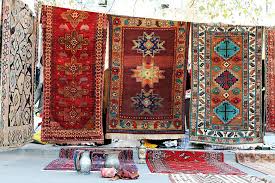Rugs from Armenia

The historian Herodotus writing in the 5th century BC also informs us that the inhabitants of the Caucasus wove beautiful rugs with brilliant colors which would never fade. Various rug fragments have been excavated in Armenia dating back to the 7th century BC or earlier. The oldest, single, surviving knotted carpet in existence is the Pazyryk carpet, excavated from a frozen tomb in Siberia, dated from the 5th to the 3rd century BC, now in the Hermitage Museum in St. Petersburg. This square tufted carpet, almost perfectly intact, is considered by many experts to be of Caucasian, specifically Armenian, origin. The eminent authority of ancient carpets, Ulrich Schurmann, says of it, “From all the evidence available I am convinced that the Pazyryk rug was a funeral accessory and most likely a masterpiece of Armenian workmanship”. Gantzhorn concurs with this thesis. It is interesting to note that at the ruins of Persepolis in Iran where various nations are depicted as bearing tribute, the horse design from the Pazyryk carpet is the same as the relief depicting part of the Armenian delegation. Armenian carpets were renowned by foreigners who travelled to Artsakh; the Arab geographer and historian Al-Masudi noted that, among other works of art, he had never seen such carpets elsewhere in his life.
Art historian Hravard Hakobyan notes that “Artsakh carpets occupy a special place in the history of Armenian carpet-making.”] Common themes and patterns found on Armenian carpets were the depiction of dragons and eagles. They were diverse in style, rich in colour and ornamental motifs, and were even separated in categories depending on what sort of animals were depicted on them, such as artsvagorgs (eagle-carpets), vishapagorgs (dragon-carpets) and otsagorgs (serpent-carpets). The rug mentioned in the Kaptavan inscriptions is composed of three arches, “covered with vegatative ornaments”, and bears an artistic resemblance to the illuminated manuscripts produced in Artsakh.
The art of carpet weaving was in addition intimately connected to the making of curtains as evidenced in a passage by Kirakos Gandzaketsi, a 13th-century Armenian historian from Artsakh, who praised Arzu-Khatun, the wife of regional prince Vakhtang Khachenatsi, and her daughters for their expertise and skill in weaving


